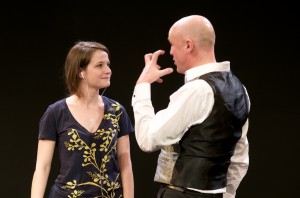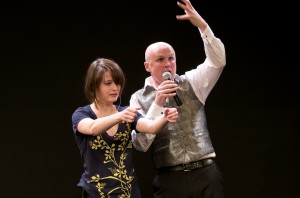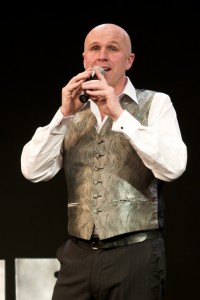
A grieving father confronting the driver responsible for his 12-year-old daughter’s death is a premise almost certain to create gripping theater. It’s hard to imagine a loss greater than a parent’s of a child, or a greater feeling of culpability than that of a person who has caused a child’s death. It’s not surprising, therefore, that Tim Crouch’s An Oak Tree proves gripping theater. What makes it quite out of the ordinary is its unusual format, one absolutely deserving to be called “unique.”
The driver is portrayed by the playwright, in a raw, searing performance. The girl’s father is played by (and here’s where things get interesting) … a different actor at each performance. The actor may be male or female and could be considerably younger or older than the character he or she is playing. Performers who have undertaken this role in An Oak Tree’s Edinburgh, London, or off-Broadway runs have included actors as diverse as F. Murray Abraham, Frances McDormand, Sophie Okonedo, and Charles Busch. Most importantly, the guest artist in each performance is an actor unfamiliar with the production, someone who meets Crouch for the first time only an hour before curtain for a brief orientation.
If this sounds like a gimmick to you, well, it is. If this sounds experimental to you, well it is that too, and not surprisingly so, the very “fringy” An Oak Tree having premiered at the Edinburgh Festival in 2005. If An Oak Tree sounds like something this reviewer would ordinarily avoid, well, that it is as well. Invitations to review gimmicky, fringy plays usually get a polite refusal, and on those occasions when I’ve attended one by accident, I’ve rarely been able to recommend the production. Experimental, avant garde theater is not this reviewer’s cup of tea.
An Oak Tree is an exception, and an exceptional one at that.
 Tim Crouch and guest performer Meagan English
Tim Crouch and guest performer Meagan English
Crouch’s play works for many reasons, perhaps the most important one being the universality of grief and guilt. There will be few audience members unable to put themselves in the shoes of either character. Who among us hasn’t heard or read or known of a young child’s death and wondered what it must be like to be the parent suffering such an irreparable loss? Who among us hasn’t wondered what it must feel like to be the one having caused this loss? David Lindsay-Abaire’s brilliant, heartbreaking Rabbit Hole works for precisely these reasons. So does Crouch’s very different An Oak Tree, ably and imaginatively directed by the playwright, Karl James, and a smith. (That’s his name, a smith, no caps.)
Opening night’s guest performer was TV/film/Broadway star Peter Gallagher, called from his seat at lights up and given only the briefest of onstage instructions by the playwright/star.
Over the course of the play’s sixty-five minutes, the guest actor occasionally reads lines from a prepared script. At other times Crouch reads his lines for him, the actor expressing the words through facial expressions and body language. Sometimes Crouch whispers lines or business to the actor from a hand-held mike, inaudible to audience members, but heard by the actor through earphones. Crouch offers (possibly scripted) encouragement to the actor (“You’re doing brilliantly, Peter”). At times he asks the actor how he is doing, or how he feels, and the actor’s responses may be either spontaneous or read from a script. As gimmicky and even contrived as this may sound, the actual experience is quite simply breathtaking. There is considerable suspense, not just in not knowing what is ahead in the script, but also in watching an actor jumping off a figurative ledge and hoping to land safely, not just once, but time and time again.
 Tim Crouch and guest performer Meagan English
Tim Crouch and guest performer Meagan English
A few more details about the plot, though no spoilers. Crouch’s character is a hypnotist who performs at local pubs. The second actor’s character shows up at one of the hypnotist’s performances. The hypnotist doesn’t recognize him and invites him to join other audience members on stage to be hypnotized.
Crouch’s performance is an amazing one, as he serves as actor, commentator, and guide, slipping effortlessly from one role to another, moving from the hypnotist’s guilty agony to a laid-back question or comment, and then back into his character’s rawest emotions once more.
Opening night guest Gallagher did a bang-up job as well, and because he took Crouch’s acting exercises so seriously and gave himself to the father’s grief so completely, it became easy to believe in the character he was portraying, despite the play’s obvious artifice. Perhaps less imagination was required of the audience on opening night, Gallagher fitting quite comfortably into the character as described by Couch. It would be fascinating to see a much younger (or older) or a female actor, as the father, and a coupon inserted into the program offers $10 off a return visit. My guess is that, like this reviewer, many will want to see the show again and compare experiences.
The set design consists of eight straight-back chairs painted silver and a black piano bench against black walls. It’s enough. William Adashek’s lighting works beautifully in tandem with the shifting moods of Crouch’s piece, as does Peter Gill’s sound design, which includes appropriately dramatic musical interludes.
I look forward to finding out who else shows up as Crouch’s costar over the coming six weeks. In a town like Los Angeles, there are bound to be some exciting choices. L.A. theatergoers are in for a treat!
Odyssey Theatre, 2055 S. Sepulveda Blvd., West Los Angeles. Through February 14.
www.odysseytheatre.com
www.anoaktreela.com
–Steven Stanley
January 6, 2010
Photos: William Adashek



 Since 2007, Steven Stanley's StageSceneLA.com has spotlighted the best in Southern California theater via reviews, interviews, and its annual StageSceneLA Scenies.
Since 2007, Steven Stanley's StageSceneLA.com has spotlighted the best in Southern California theater via reviews, interviews, and its annual StageSceneLA Scenies.







 COPYRIGHT 2024 STEVEN STANLEY :: DESIGN BY
COPYRIGHT 2024 STEVEN STANLEY :: DESIGN BY